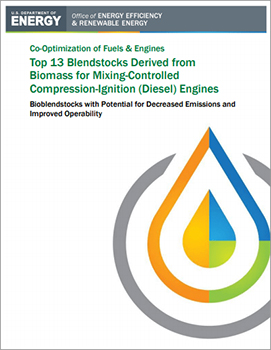 On July 8, 2021, the U.S. Department of Energy’s Co-Optima initiative published Top 13 Blendstocks Derived from Biomass for Mixing-Controlled Compression-Ignition (Diesel) Engines: Bioblendstocks with Potential for Decreased Emissions and Improved Operability, a 145-page report with a 22-word title and plenty of food for thought.
On July 8, 2021, the U.S. Department of Energy’s Co-Optima initiative published Top 13 Blendstocks Derived from Biomass for Mixing-Controlled Compression-Ignition (Diesel) Engines: Bioblendstocks with Potential for Decreased Emissions and Improved Operability, a 145-page report with a 22-word title and plenty of food for thought.
To make a long story short, here are those top 13 blendstocks:
- Farnesane
- Fischer-Tropsch diesel
- Hydrothermal liquefaction from wet waste, algae and alge-wood blends
- Isoalkanes made from ethanol
- Isoalkanes via volatile fatty acids from food waste
- Hydroprocessed esters and fatty acids (renewable diesel)
- Short chain esters from oilseed crops
- Fatty acid methyl esters (biodiesel)
- Fatty acid fuel esters
- 4-butoxyheptane
- Polyoxymethylene esthers (POMEs)
- Alkoxyalkanoates
- Fatty alkyl esthers
All of these deliver greenhouse gas reductions of at least 60% compared to petroleum diesel. Additionally, they produce less soot, improve cold-weather performance, and have a higher cetane number. In other words, they’re not only predominantly compatible with existing infrastructure and therefore cost competitive, but also may improve engine performance and therefore lower the cost of vehicle ownership.
You can find out more about the study in articles by the DOE’s Bioenergy Technologies Office and Pacific Northwest National Laboratory, or, if you’re in the mood for a light summer read to cap off your summer, follow the image-link above to open up the full report.
